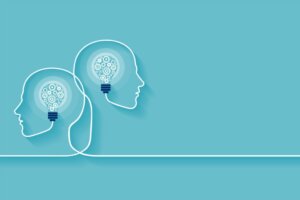Fast and Slow Thinking by Daniel Kahneman


Written and verified by the psychologist Laura Ruiz Mitjana
Are you aware of how your brain activates the two systems of thought while you perform your daily tasks? Do you know how you make decisions? Although there are many psychological theories on this subject, one of them has been particularly influential. It’s a theory on thinking by Daniel Kahneman.
Kahneman is a psychologist who received the Nobel Memorial Prize in Economic Sciences in 2002. He wrote a bestseller, Thinking, Fast and Slow, in 2012. In it, he exposes a theory on two well-differentiated systems of thought. System 1 is more intuitive, fast, and automatic, while system 2 is more deliberative, logical, and slow. So what else is there to know about these systems? When do you use them? Do they interact with one another? Continue reading to find out.
“Strong thoughts are accompanied by great emotions.”
-Bangambiki Habyarimana-

Fast and slow thinking according to Daniel Kahneman
Kahneman’s systems of thought are the subject of the book titled Thinking, Fast and Slow. Daniel is a Palestinian-born psychologist who grew up in the United States. Many think he’s one of the most important thinkers in the world. As we mentioned above, he won the Nobel Prize for his work on the rational model of decision-making.
His ideas influenced many areas of medicine, politics, and economics. In his book, Daniel described two types of thought or systems that model human thinking. System 1 is fast, intuitive, and emotional, while System 2 is slower, deliberative, and logical.
System 1 (fast)
This thought system is a fast, automatic, and emotional system that’s also stereotyped and subconscious. System 1 has the function of generating intuitions that can be useful for human tasks (even though they aren’t always useful). This system is also known as an implicit system.
Also, system 1 activates through intuition and heuristics. It allows you to do basic daily tasks, such as walking or brushing your hair. In addition, it associates new information with patterns that already exist in the mind, at least according to Kahneman. Thus, the mind doesn’t create new patterns from each new experience but associates new information with old information through it, creating meaningful relationships.
How does it activate?
Humans use System 1 to decide most of the issues of our daily lives. That is, it allows you to make quick and simple decisions and reach automatic conclusions.
System 2 (slow)
The second system proposed by Kahneman is slower and requires a greater effort. It’s less common and more logical than the previous one, as well as calculating and conscious. That is, when humans use System 2, they’re fully aware it’s for problem-solving, for example.
Its function is to make final decisions after watching and controlling the intuitions that arise from System 1. Unlike it, System 2 allows you to carry out more complex tasks such as learning a language or reflecting on something.
How does it activate?
The second system is for making complex or difficult decisions. Therefore, it’s a more deliberate type of thinking. It’s a system that requires more concentration since it prevails faced with complex tasks. In addition, humans use this system to give conscious answers.

Interaction of the two systems of thinking by Daniel Kahneman
These two thought systems are continuously active in human daily life and communicate with each other. However, each will dominate the other depending on the task at hand.
Each of the systems has a function. Thus, while System 1 determines your thoughts in relation to the perceptions of the environment and the visual and associative memory, System 2 is in charge of developing conclusions from the intuitions of the first one. The deliberative system can be useful when making complex decisions since it’s slower and requires more concentration than the previous one (concentration is a key factor in decision-making). This is why Kahneman refers to the second process as slow thinking.
In terms of their interaction, System 1 has a greater influence on behavior when System 2 is busy.
In short, Daniel Kahneman says that thinking manifests through two thought systems that operate in the mind to help make decisions and solve problems. However, he said in an interview that people don’t reflect on which of the two systems is dominating over the other and, thus, directing their behavior most of the time.
Are you aware of how your brain activates the two systems of thought while you perform your daily tasks? Do you know how you make decisions? Although there are many psychological theories on this subject, one of them has been particularly influential. It’s a theory on thinking by Daniel Kahneman.
Kahneman is a psychologist who received the Nobel Memorial Prize in Economic Sciences in 2002. He wrote a bestseller, Thinking, Fast and Slow, in 2012. In it, he exposes a theory on two well-differentiated systems of thought. System 1 is more intuitive, fast, and automatic, while system 2 is more deliberative, logical, and slow. So what else is there to know about these systems? When do you use them? Do they interact with one another? Continue reading to find out.
“Strong thoughts are accompanied by great emotions.”
-Bangambiki Habyarimana-

Fast and slow thinking according to Daniel Kahneman
Kahneman’s systems of thought are the subject of the book titled Thinking, Fast and Slow. Daniel is a Palestinian-born psychologist who grew up in the United States. Many think he’s one of the most important thinkers in the world. As we mentioned above, he won the Nobel Prize for his work on the rational model of decision-making.
His ideas influenced many areas of medicine, politics, and economics. In his book, Daniel described two types of thought or systems that model human thinking. System 1 is fast, intuitive, and emotional, while System 2 is slower, deliberative, and logical.
System 1 (fast)
This thought system is a fast, automatic, and emotional system that’s also stereotyped and subconscious. System 1 has the function of generating intuitions that can be useful for human tasks (even though they aren’t always useful). This system is also known as an implicit system.
Also, system 1 activates through intuition and heuristics. It allows you to do basic daily tasks, such as walking or brushing your hair. In addition, it associates new information with patterns that already exist in the mind, at least according to Kahneman. Thus, the mind doesn’t create new patterns from each new experience but associates new information with old information through it, creating meaningful relationships.
How does it activate?
Humans use System 1 to decide most of the issues of our daily lives. That is, it allows you to make quick and simple decisions and reach automatic conclusions.
System 2 (slow)
The second system proposed by Kahneman is slower and requires a greater effort. It’s less common and more logical than the previous one, as well as calculating and conscious. That is, when humans use System 2, they’re fully aware it’s for problem-solving, for example.
Its function is to make final decisions after watching and controlling the intuitions that arise from System 1. Unlike it, System 2 allows you to carry out more complex tasks such as learning a language or reflecting on something.
How does it activate?
The second system is for making complex or difficult decisions. Therefore, it’s a more deliberate type of thinking. It’s a system that requires more concentration since it prevails faced with complex tasks. In addition, humans use this system to give conscious answers.

Interaction of the two systems of thinking by Daniel Kahneman
These two thought systems are continuously active in human daily life and communicate with each other. However, each will dominate the other depending on the task at hand.
Each of the systems has a function. Thus, while System 1 determines your thoughts in relation to the perceptions of the environment and the visual and associative memory, System 2 is in charge of developing conclusions from the intuitions of the first one. The deliberative system can be useful when making complex decisions since it’s slower and requires more concentration than the previous one (concentration is a key factor in decision-making). This is why Kahneman refers to the second process as slow thinking.
In terms of their interaction, System 1 has a greater influence on behavior when System 2 is busy.
In short, Daniel Kahneman says that thinking manifests through two thought systems that operate in the mind to help make decisions and solve problems. However, he said in an interview that people don’t reflect on which of the two systems is dominating over the other and, thus, directing their behavior most of the time.
All cited sources were thoroughly reviewed by our team to ensure their quality, reliability, currency, and validity. The bibliography of this article was considered reliable and of academic or scientific accuracy.
- Garnham, A. y Oakhill, J. (1996) Manual de Psicología del Pensamiento. Ed. Paidós.
- Kahneman, D. (2012). Pensar rápido, pensar despacio. Ed. Debate.
This text is provided for informational purposes only and does not replace consultation with a professional. If in doubt, consult your specialist.







